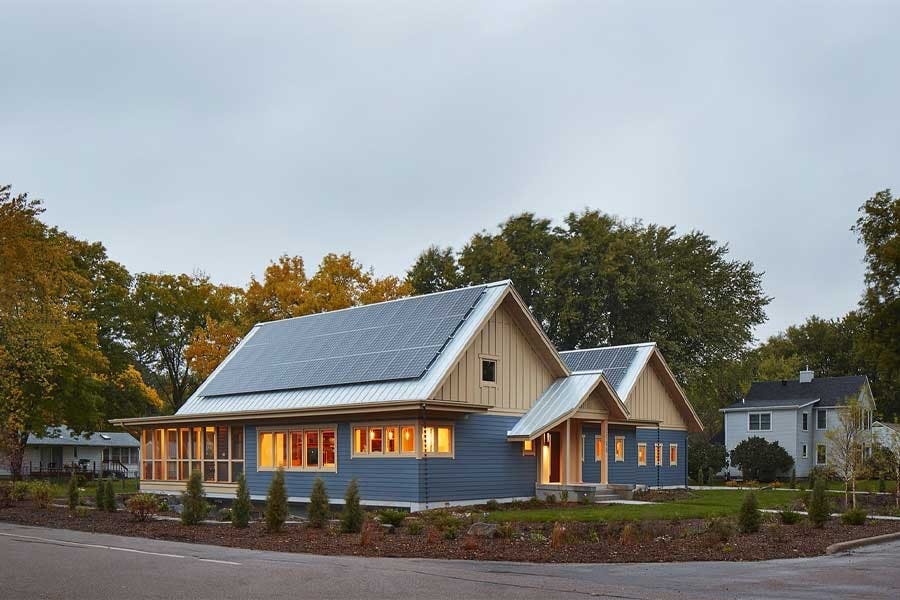Inside the build: How one Minnesota family created a net-zero home
The Challenge
“They had lofty goals,” said SALA Architect’s Marc Sloot, architect of the Hanson’s home. With most people when you talk to about Net Zero, “it’s about the house itself. But they came in and said, ‘we want to do our house and our cars’”.
Unlike many renewable energy home building projects, the Hansons wanted to build in an urban neighborhood, close to their jobs and where they’d have access to all the amenities of the city. It would have been easier to build in a suburban or rural setting where there is a greater choice of land parcels ideal for solar positioning and with fewer building codes and requirements to contend with.
With the goal of finding a lot in an urban setting to build a Net Zero home that could produce enough energy to power the house and two electric cars in mind, the Hansons were ready to move forward.
The Solution
The Hansons started by assembling the right team to achieve their home, beginning with SALA Architects and Sloot. Fortunately, Sloot has built his career around sustainable energy and could connect them to a realtor familiar with green building needs. Eventually, they found a great location in the Twin Cities of Minneapolis and Saint Paul, Minnesota with great solar access that had the potential to achieve their lofty goals.
As design began on the layout of their home, it became clear that the best way to have enough panels to meet their energy needs without building a huge house – bigger than they wanted – was to separate the main part of the house from the garage creating two, perfectly angled slopped roofs.
The south slope of the roofs is 12-12 pitch which is a 45-degree angle and optimal for solar panels at this latitude. The north slopes are down to a 9-12 pitch. By using different pitches, Sloot was able to lower the ridge of the house to allow better solar access to the solar panels on the garage.
At the time of writing, the Hansons had just completed their first energy year in review and proved that they indeed produced more energy than they used – including charging their two electric cars – for an entire year.
The Role of Windows
Windows play an important role not just in the massing, exterior attractiveness and interior mood of the design, but also in the energy efficiency and passive solar gain – something that was very important to the Hansons and Sloot.
“We used fixed windows as much as we could and strategically placed operable windows on opposite sides of the house,” for cross ventilation, said Sloot. They selected Andersen® A-Series windows with triple-pane glass because they are recognized for being most efficient. Because there are two air gaps between the three panes of glass they have a lower condensation potential from the gaps and more surfaces for coatings to help with the solar heat gain coefficient.
In the winter, solar energy is collected through the bank of windows all along the south side of the home. Not only does this lower heating costs, but it also adds to the aesthetic of the home. “I love having this bank,” said homeowner Kate Hanson, “That open and airy feeling it gives to our house is my favorite thing.”
In the summer, solar heat is rejected from the home by use of right-sized overhangs. The roof provides shade for the main floor windows. The lower level of the home is tucked in under the main level to provide shading in the same way.
Their Advice
Having survived the building process and finding themselves now living in their dream home, Mark and Kate have a lot of solid advice for others interested in building their own Net Zero home.
“Get a good team together,” said Mark Hanson. “Find yourself a good architect and a builder. Experience building Net [Zero] homes is not a requirement, but a willingness to learn is. And then build the team out from there.”
“Be ready to plan and spend the time to work out the details in advance,” said Kate Hanson. “And don’t be afraid to say ‘yes’ or ‘no’ or ‘I’m not sure I like that detail’ or ‘I don’t understand how that thing works, can you explain it more to me?’”.
Architect Marc Sloot also had advice for architects and builders on how to engage owners who are building their first Net Zero home.
“You really need to focus on what attributes are going to be meaningful to them,” said Sloot. “It’s important for [the homeowners] to know that it’s still, at the core, about making a beautiful, comfortable home and the Net Zero part of it is making it that much more affordable to live in.”
